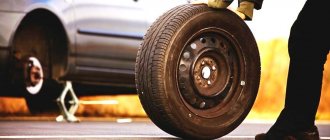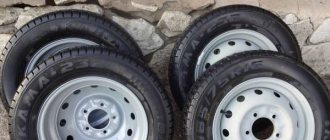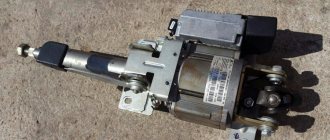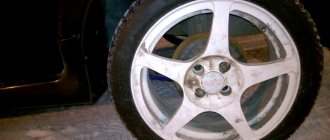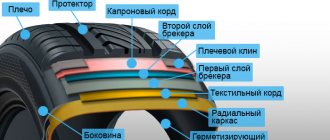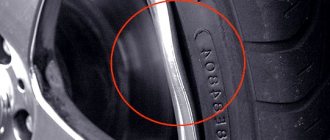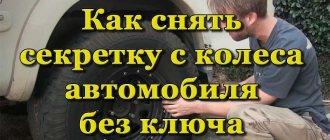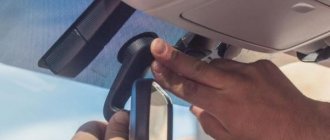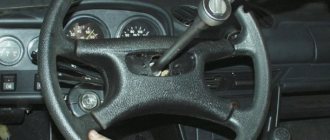Structurally, the wheel is the chassis of the vehicle; with the help of wheels, movement is carried out and vertical loads are transmitted. In addition, they soften mechanical impacts and vibrations at the moment of contact with the road surface, providing maneuverability and traction. The aerodynamics and controllability of vehicles depend on them.
So, we figured out what a wheel is. Now about its components. The wheel includes two structural parts: a tire and a disk.
Purpose, functions
In general, car wheels are divided into three categories, depending on the function they perform - driving, steering, supporting. The drive wheels are rotated and, through contact with the road, they cause the car to move. But in the process of moving a car, it is necessary to change the direction of movement, maneuver, and the steered wheels are responsible for this.
Trucks are designed to transport goods and to reduce the load on the drive and steered wheels; support wheels have been added to the design of the chassis. They do not set the car in motion, do not participate in maneuvering, their task is to take part of the load “on themselves”.
Passenger cars use 4 wheels, but in trucks their number can reach 12, and in special equipment - up to 24. It is noteworthy that on trucks the wheels are usually divided into categories - some of them are driving, the second are steered, and the rest are supporting.
Drive cars
As for passenger vehicles, the types of car wheels they use can be divided according to their intended purpose or be combined. For example, in rear-wheel drive models, the wheels installed on the rear axle are driven, and those on the front axle are steered. But in front-wheel drive versions, the wheels of the front axle are both driven and steered, while the rear wheels perform only a supporting function.
Questions on the topic
Filter:AllOpenSolvedClosedWaiting for response
Which wheels to choose for a VAZ 2107? Answered by User answered 8 months ago • Tires and wheels
24 views 1 answer. 0 vote.
Will 225/50 R18 tires fit the Hyundai Sonata VII? Answered by User answered 8 months ago • Tires and wheels
25 views 1 answer. 0 vote.
What should be the tire pressure for Toyota Land Cruiser Prado 4? Answered by User answered 8 months ago • Tires and wheels
23 views 1 answer. 0 vote.
Can tires with different treads be used on the same car? Answered by User answered 8 months ago • Tires and wheels
24 views 1 answer. 0 vote.
What is the service life of tires? Answered by User answered 8 months ago • Tires and wheels
23 views 1 answer. 0 vote.
Why doesn't the tire pressure indicator work? Answered by User answered 8 months ago • Tires and wheels
25 views 1 answer. 0 vote.
What are the parameters of VAZ 2106 wheels? Answered by User answered 8 months ago • Tires and wheels
26 views 1 answer. 0 vote.
What size rims are on Volkswagen Passat? Answered by User answered 8 months ago • Tires and wheels
25 views 1 answer. 0 vote.
Can you tell me the wheel sizes for Nissan Qashqai? Answered by User answered 8 months ago • Tires and wheels
25 views 1 answer. 0 vote.
Can you tell me the size of the rims for the Jeep Liberty? Answered by User answered 8 months ago • Tires and wheels
29 views 1 answer. 0 vote.
Ask a Question
Requirements for wheels. Components
The design of these chassis components includes two components - a disk and a tire. But despite this, the structure of a car wheel is quite complex and many requirements are put forward to them:
- be durable;
- provide good grip on the road surface;
- securely attached to the chassis;
- absorb impacts from minor road irregularities;
- serve for a long time.
The wheel rim acts as a seating base for the tire and at the same time secures the wheel to the chassis. This component is subject to significant loads while driving, since they are the first to absorb vibrations from road irregularities and transmit them to the suspension.
Read also
8.1. Purpose and types of repairs
8.1. Purpose and types of repair Dismantling is the operation of disassembling a machine or equipment into assembly units, components and parts. In this case, detachable and, in some cases, permanent connections are disassembled. Machine repair is called restoration
Types, purpose and methods of manufacturing formwork and inventory scaffolding
1. Types, purpose and methods of manufacturing formwork and inventory scaffolding When constructing buildings and structures made of monolithic concrete and reinforced concrete, formwork is used. Formwork is a form in which reinforcement and concrete mixture or one concrete mixture are placed
Chapter 1 PURPOSE AND TYPES OF GLASS WORK
Chapter 1 PURPOSE AND TYPES OF GLASS WORK In rooms with constant occupancy of people, including residential, public and industrial buildings, good natural lighting must be organized. Natural lighting can be side, top,
Purpose of the crank mechanism
Purpose of the crank mechanism The crank mechanism (abbreviated KShM) ensures the conversion of the translational-rotational movement of the piston inside the cylinder into the rotational movement of the engine crankshaft. The standard four-cylinder
Purpose and design of the vehicle chassis
Purpose and design of the chassis of a car The main purpose of the chassis of a car is to connect the wheels with its body, dampening vibrations that occur during driving and ensuring a smooth and soft ride, and therefore comfort
Wheel camber and toe
Wheel alignment and camber Many beginners do not even suspect that the front wheels of the car are not installed parallel to each other and not perpendicular to the surface of the roadway. They are slightly turned one to one (this is called “wheel toe”), and relatively
Design and purpose of the gearbox
Design and purpose of the gearbox The gearbox (abbreviated as gearbox) is designed to change the torque in magnitude and direction and transmit it from the clutch (we will get acquainted with the clutch mechanism in the next section) to
Wheel brakes
Wheel brake mechanisms The wheel brake mechanism, as we noted earlier, is present on each wheel. It is designed to reduce the speed of rotation of the wheel until it stops completely due to the friction force that occurs between the brake pads and the brake
Stands. Purpose and device
Stands. Purpose and device Repair of frameless bodies requires the use of special repair methods and special equipment. The base does not detach from the body frame, like in frame cars. This design requires a rigid base that serves as a reference point for
FINISH DETAILS, THEIR PURPOSE AND IMPLEMENTATION
FINISH DETAILS, THEIR PURPOSE AND IMPLEMENTATION Platbands (Fig. 211, a) not only decorate the house from the outside, but also close the gap between the wall and the window frame. In addition to the picture on the flyleaf, there are various types of platbands found in Moscow, Tula, Smolensk,
FUNCTIONAL PURPOSE
FUNCTIONAL PURPOSE Flooring is used everywhere: at home, in the country, in an office center, so a number of very diverse requirements are placed on it. When choosing a floor covering, you should pay attention to the following characteristics:? durability and
WHEEL BALANCING IS VERY IMPORTANT
WHEEL BALANCING IS VERY IMPORTANT Progress is moving by leaps and bounds, dear fellow motorists - until recently, it seems like we were driving on diagonal, and even fatty tires, and the words “summer tires”, “winter, studded tires”, the concept of “wheel balancing” " were
Disk
A wheel rim consists of two elements – the rim itself and the rim. There are four types of car wheels available: welded steel (stamped), solid cast (alloy, forged), combined and composite. In the first type, the disk and the rim are two different elements connected to each other by welding. In alloy wheels, its components are a single one-piece structure.
The third type is the so-called combined or collapsible discs, which come in two or three parts. They are the best discs in all respects, since the central section is usually cast and, accordingly, any design can be obtained, and the rim is made by stamping. The fourth and rarest type is composite, their cost is simply prohibitive due to the complex production technology and therefore they can only be seen on sports cars.
Disc is an element that secures the wheel. To do this, a mounting hole is made in the center, along the circumference of which there are mounting holes. The number of mounting holes on passenger cars varies from 3 to 5, while on trucks there are usually 6-8. The disc is fixed to the hub either with bolts or studs with nuts.
Alloy wheel design
The rim is designed to accommodate a tire. It has a complex transverse profile, which is necessary for the correct and reliable fit of the stingray. If we look at the rim in profile, it has a stepped shape.
The center of the rim is presented in the form of a recessed platform to which the disk adjoins. On both sides of the center there are steps, which are formed by a ring protrusion (hump), a shelf and a side.
The hump is designed to secure the tire in the rim and prevent it from moving towards the center of the rim. The shelf acts as a landing platform for the side of the ramp. The rim flange holds the tire on the shelf and prevents it from “falling off.”
Note that this is the most common type of disk. But on trucks and special equipment you can find other types of car disks - with a locking ring, collapsible (the disk consists of two halves, held together by a bolted connection).
Causes of failure and replacement of the hub
A broken hub can cause the brake system to malfunction. If a part breakdown is detected and repaired in time, you can avoid serious accidents and costs for more complex repairs. The reasons for the failure of a bearing part can be: aggressive and careless driving, “drifting”, rubbing the belly of the car with gravel, sand or mud slurry on the roads, regularly getting wheels into holes and bumps, overload. In some cases, a spare part may fail due to an initial defect during assembly at the factory. Among the main signs of failure of a spare part are weak shocks, an unpleasant sound, a feeling of body vibration, and motion sickness.
Knocking and hearing will help determine if the hub is broken.
— The first way is to knock on the wheel with your foot. Tires should neither wobble nor play from light impacts. If you feel wobbly or notice a gap between the parts when tapping, then this is a signal of a breakdown.
— Another option is to listen while driving. If an unpleasant cutting sound or any other extraneous rustle is heard from under the wheels, the wheel part should be replaced immediately.
On the front and rear wheels, a spare part malfunction is determined differently. This is easier to do on the front tires. You need to accelerate the car to a speed of 60 km/h or higher and swerve along the road in different directions. If the left bearing is broken, the sound will increase when turning left, and if the right one - accordingly, when turning right. Faulty hubs on the rear wheels behave differently. It is difficult to determine which one is broken. It happens that an unpleasant sound comes from the right, but the left part is broken. Experienced motorists advise lifting the rear of the car and then turning the wheel in different directions. One and the other. Where you hear a crunching sound, an extraneous sound, or find play, repair or replacement of the part is needed.
Bus device
The tire is the second component of the wheel. It also has a rather complex design, since its task is to provide adhesion to the road surface, absorb and dampen vibrations from small irregularities, and retain weight. To perform its functions, the tire must be durable, but at the same time elastic. Note that the tire is a kind of shell that is filled with filler - air or special gases.
The tire consists of an elastic radial frame that gives the shape of the product, onto which a rubber layer, a breaker (power metal cord), a bandage of threads (nylon cord) and a tread are successively applied. Along the inner circumference, the radial frame forms the tire bead, into which a wire ring is installed for rigidity.
One of the bus schemes
The visible elements of the tire are the tread, which acts as the main working surface (it is in contact with the road surface) and the sidewall. The transition between these elements is called the shoulder.
To ensure traction on the road, the tread has a complex pattern, which is formed by ribs, blocks with grooves and lamellas.
Marking
On the sidewall of the tire you can see the inscription 185/60 R15. It means:
- 185 – its width in millimeters,
- 60 – ratio of tire height to width in percent,
- R – radial design (with radial threads),
- 15 – bore diameter in inches (one inch equals 2.54 centimeters).
The mistake of many car enthusiasts is the misconception that the letter R in the marking indicates the radius. This letter has nothing to do with the number 14. It indicates that this tire is of a radial design, as opposed to the outdated diagonal ones. And the number 14 is the landing diameter along the wheel rim. 14 inches = 356 mm.

